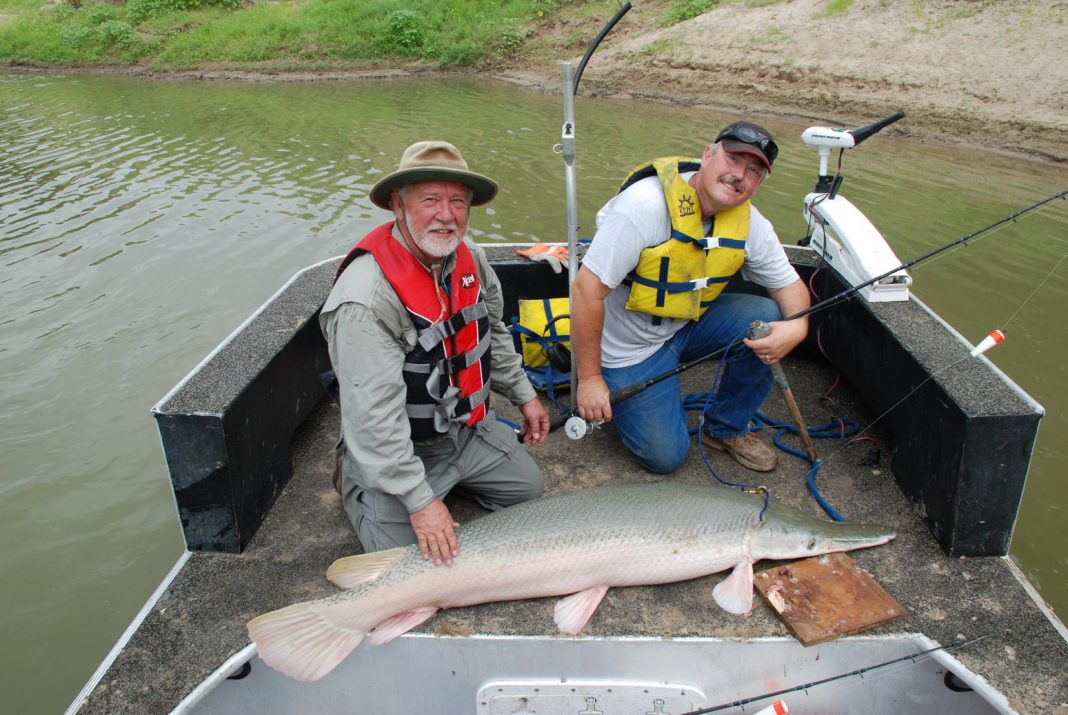UPDATE: On March 20, The Texas Parks & Wildlife Commission adopted a suite of changes to this year’s freshwater fishing regulations that includes modifications to the length limits and harvest regulations for largemouth bass, Alabama bass and alligator gar in certain areas. The proposed changes to gar regulations also include a nighttime prohibition on bow fishing on the Trinity River, mandatory harvest reporting statewide except for Falcon International Reservoir and the creation of a drawing for harvest opportunities on the Trinity.
The Commission adopted the following changes to the 2019-20 Statewide Recreational and Commercial Fishing Proclamations:
- Lake Lakewood: Implement an 18-inch minimum length limit and three-fish daily bag for largemouth bass.
- Mill Creek Lake: Change from a 14- to 21-inch slot length limit and five fish daily bag limit for largemouth bass to a 16-inch maximum length limit and five-fish daily bag with an exception allowing for possession and weighing for bass 24 inches or greater for possible submission to ShareLunker program.
- Southeast Texas: Expand the area in Southeast Texas currently covered by the 12-inch minimum length limit for largemouth bass to include Hardin County, Newton County (excluding Toledo Bend Reservoir), and Liberty County south of U.S. Highway 90.
- Alan Henry Reservoir: Modify the harvest regulations for largemouth and Alabama bass by removing Alabama bass from the current regulation (five-fish daily bag of which only two bass less than 18 inches may be harvested). The combined daily bag limit would remain at five fish, but anglers may harvest Alabama bass of any length.
- Trinity River:
- Enact a 48-inch maximum length limit for alligator gar on the Trinity River from the I-30 bridge in Dallas downstream to the I-10 bridge in Chambers County, including the East Fork of the Trinity River upstream to the dam at Lake Ray Hubbard.
- A drawing will be implemented to allow selected anglers to harvest one alligator gar over 48 inches in length per year from the Trinity River. The draw system would allow non-transferable harvest authorization for a to-be-determined number of alligator gar. Authorizations would be selected and distributed through a random draw of interested applicants. Purchase of a fishing license would be required. This authorization could be used day or night, and alligator gar could be taken by any legal means.
- Between one half-hour after sunset and one half-hour before sunrise, no person may take or possess an alligator gar by means of lawful archery equipment or crossbow on the Trinity River unless they have received a harvest authorization through the drawing system.
- Statewide: All persons who take an alligator gar from the public fresh waters of the state other than Falcon International Reservoir would be required to report the harvest via the department’s website or by mobile app within 24 hours of take.
The commission did not move forward with proposals that would ban bow fishing for alligator gar at night statewide or to change current regulations on Lake Conroe for largemouth bass from a 16-inch minimum length limit and 5-fish daily bag limit to a 14-inch minimum length limit and 5-fish daily bag limit.
The changes to the 2019-20 Statewide Recreational and Commercial Fishing regulations take effect Sept. 1.
Texas’ alligator gar fishery as a whole is exceptional, with multiple locales offering numerous opportunities to catch fish weighing in excess of 100 pounds, and some offering a real shot at a 200-pounder.
While gar — especially those in the above weight class — are a known quantity in Texas fishing circles, there are many things that remain unknown or murky about these ancient fish. To help protect the fishery — and fish that are really old when they hit these kinds of weights — the Texas Parks & Wildlife Department is considering a number of proposals that would “help the Department conserve and prevent the overharvest of older, mature alligator gar, fill data gaps through mandatory harvest reporting and allow for limited opportunity to harvest large alligator gar from the Trinity River by creating a drawing system.”
Alligator gar can live for decades and grow fast when young. However, growth slows with age. In general, for every additional foot the fish grows, its age doubles. A 3-foot gar is typically about 2.5 years old, a 4-foot gar about 5, and a 7-foot trophy catch might be 40 years old. The world record, caught in Mississippi in 2011, weighed 327 pounds and was probably at least 95. Alligator gar are slow to mature and usually don’t spawn until they are about 10 years old.
The first of four components of the proposed regulation changes include implementing a 4-foot maximum length limit on the Trinity River, the Lone Star State’s premier destination for anglers pursuing large gar. Under this rule change, anglers would not be allowed to harvest any alligator gar over that length from the Trinity River from the I-30 bridge in Dallas downstream to the I-10 bridge in Chambers County, including the East Fork of the Trinity River upstream to the dam at Lake Ray Hubbard, according to TPWD.
“The TPW Commission has communicated to us that they would rather, out of an abundance of caution, act proactively to further limit harvest of older, mature alligator gar while populations are in relatively good shape,” said Craig Bonds, TPWD Inland Fisheries Director, in a department news release. “The 4-foot maximum would conserve these larger fish and redirect harvest towards younger, more abundant smaller fish. It also ensures there are plenty of large, recreationally valuable fish remaining for anglers to catch and release, which attracts anglers from around the world.”
The second part of the proposed regulation changes would create a drawing to allow selected anglers to harvest one gar over 48 inches in length per year from the Trinity. The limited entry system would “allow non-transferable harvest authorization for a set number of alligator gar. Authorizations would be selected and distributed through a limited random draw of interested applicants.”
“The drawing is similar to what other states like Arkansas are doing to offer an opportunity to keep one large gar while allowing the Department to manage annual harvest to avoid a population decline and depletion of the large alligator gar,” said Bonds, in the release. “Alligator gar could be harvested by lawful means, including pole-and-line or by bow fishing equipment.”
The final two proposed rule changes would be in effect statewide. This includes a proposed prohibition on nighttime bow fishing for alligator gar 30 minutes after sunset to 30 minutes before sunrise, which includes take and possession using lawful archery equipment including crossbows during those nighttime hours.
“The TPW commission has concerns about the rapid evolution of technology and equipment used to target large alligator gar,” Bonds noted. “Prohibiting nighttime bow fishing for alligator gar is an additional proactive measure that would be taken to protect populations from overharvest.”
The final component of the proposed regulation changes would require all anglers harvesting alligator gar to report their harvest within 24 hours online or through a mobile app, similar to what is required for eastern turkey in Texas. This system “would give TPWD more data on alligator gar numbers to try to ensure quality fishing for future generations of anglers.”
Statewide, a one-fish-per-day bag limit would remain in effect, and at Falcon International Reservoir on the extreme southern border of Texas, the daily bag limit of five fish and possession limit of 10 fish would also remain in effect. Falcon also would be exempt from the harvest reporting requirement, TPWD officials noted.
“We are proposing to exempt Falcon from mandatory harvest reporting as this lake appears to have a robust population of alligator gar so that information is not needed at this time to manage that particular fishery,” quoted Bonds, in the release.
The Texas state record is 302 pounds, caught on a trotline in 1953. Bow fishers and rod and reel anglers have landed several specimens in excess of 200 pounds. Historically considered a “rough fish,” the alligator gar has recently gained popularity as a sport fish, attracting national and international attention after being featured on several television shows. Texas Parks & Wildlife imposed a one-per-day bag limit on alligator gar beginning in 2009.
TPWD also is taking public comment on proposed changes on other freshwater fishing regulations, with input to be considered before action by the TPWD Commission at its March 20 public hearing in Austin.
Here’s a rundown of all the freshwater fishing proposals being considered for 2019-20:
- Lake Conroe: Change current regulations for largemouth bass from a 16-inch minimum length limit and 5-fish daily bag limit to a 14-inch minimum length limit and 5-fish daily bag limit.
- Lake Lakewood: Implement an 18-inch minimum length limit and three-fish daily bag for largemouth bass.
- Mill Creek Lake: Change from a 14- to 21-inch slot length limit and five fish daily bag limit for largemouth bass to a 16-inch maximum length limit and five-fish daily bag with an exception allowing for possession and weighing for bass 24 inches or greater for possible submission to ShareLunker program.
- Southeast Texas: Expand the area in Southeast Texas currently covered by the 12-inch minimum length limit for largemouth bass to include Hardin County, Newton County (excluding Toledo Bend Reservoir), and Liberty County south of U.S. Highway 90.
- Alan Henry Reservoir: Modify the harvest regulations for largemouth and Alabama bass by removing Alabama bass from the current regulation (five-fish daily bag of which only two bass less than 18 inches may be harvested). Alabama bass would revert to the statewide limits (no length limit and five-fish daily bag in combination with largemouth bass).
- Trinity River: Enact a 48-inch maximum length limit for alligator gar on the Trinity River from the I-30 bridge in Dallas downstream to the I-10 bridge in Chambers County, including the East Fork of the Trinity River upstream to the dam at Lake Ray Hubbard.
- Trinity River: A drawing will be implemented to allow selected anglers to harvest one alligator gar over 48 inches in length per year from the Trinity River. The limited entry system would allow non-transferable harvest authorization for a set number of alligator gar. Authorizations would be selected and distributed through a random draw of interested applicants.
- Statewide: Between one half-hour after sunset and one half-hour before sunrise, no person may take or possess an alligator gar by means of lawful archery equipment or crossbow.
- Statewide: All persons who take an alligator gar from the public fresh waters of the state other than Falcon International Reservoir would be required to report the harvest via the department’s website or by mobile app within 24 hours of take.
There are multiple ways to provide your public comment into the proposals, with the easiest being online.





















Despicable that TPWD would wage war with bowfishing enthusiasts with respect to gar based on some cautionary BS, rather than within the scope of their actual responsibility of proposing regulations–based on science.
do alligator gar have any benefit? i feel like they just eat all the fish we like to catch.